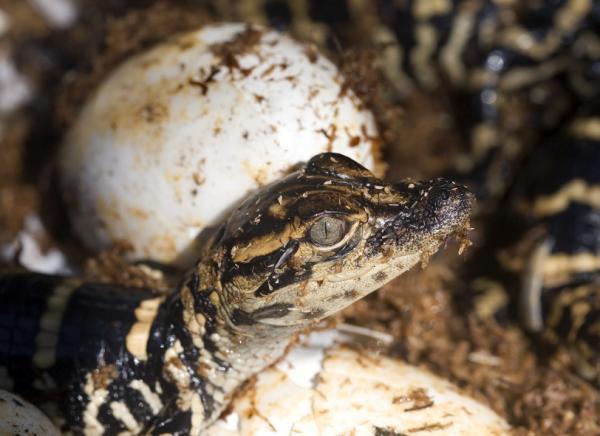During 540 million years ago, the concentration of oxygen on the earth fluctuated strongly. Dinosaurs existed at a time when oxygen levels reached a minimum of 12%. Knowing this, Tomasz Owerkowicz, Ruth Elsey and James Hicks have asked why these giant monsters can withstand such low oxygen levels. There is no need to search for dinosaurs to verify their point of view, Owerkowicz and Hicks turn to their modern relatives: the American crocodile.
Owerkowicz explains: 'We know that testing the impact of different oxygen levels on American alligators will result because the crocodile has survived its basic shape for 220 million years. Surely they must hold the secret of the existence of the oxygen concentration '. The set of three researchers chose the time right from the beginning of the development process in crocodiles, they decided to try to hatch crocodile eggs at different oxygen concentrations to seek answers to the questions by Which ancient crocodiles can grow and develop.
Receiving newborn crocodile eggs from Elsay at the Rockefeller wildlife reserve, Owerkowicz divided the eggs into groups that carried incubation at oxygen concentrations of 12% (low), 21% (normal) and 30% (high) then wait for the next thing to happen. After 10 weeks, the eggs start to hatch . Owerkowicz found no significant difference between the crocodiles hatched under high normal oxygen concentration conditions.
But he was shocked when crocodiles hatched in low oxygen conditions began to hatch. Their tiny belly flattened out. They cannot absorb all the egg yolk, making their stomachs full of yolk. The abdomen is so big that their feet cannot touch the ground. They sit only until the entire yolk has been used up and they start moving.
 Newly hatched eggs and crocodiles. (Photo: iStockphoto / Clark Wheeler)
Newly hatched eggs and crocodiles. (Photo: iStockphoto / Clark Wheeler)
Owerkowicz said that because there was not enough oxygen, the embryo consumed all the yolk. The internal organs of hatched animals in conditions of low oxygen levels are also much smaller, except for the relatively large heart perhaps to make the most of the limited oxygen supply. Owerkowicz admits that he once thought that the lungs of these newly hatched crocodiles would grow to compensate for the low oxygen supply but the truth was not true.Perhaps due to the hatched crocodiles do not use the lungs and take oxygen through the blood vessels in the egg membrane.
Then Owerkowicz was curious to know the activities of American crocodiles after three months of existence in their environment. When examining the rate of breathing and metabolism, they found that the animals that lived in abundant oxygen conditions breathed much less than the crocodiles in the other two groups. Perhaps they inhale more oxygen each time, while converting into the accumulated energy used for maturation. When Owerkowicz examined the lung size of 3-month-old crocodiles living in low oxygen conditions, he noticed everything as he expected, their lungs larger than those living in conditions. normal oxygen. The lungs swelled to compensate for the limited supply of oxygen, which allowed alligators to increase the body's metabolic rate but still could not be equal to the other two groups.
Owerkowicz acknowledged that although his results could not give us an accurate answer to the lives of prehistoric crocodiles, their development and metabolism were clearly changed. tell.
Refer:
Owerkowicz, T., Elsey, RM and Hicks, JW Atmospheric oxygen level growth test, all cardometry and metabolic rate in the American alligator (Alligator mississippiensis).Journal of Experimental Biology, 2009;212 (9): 1237 DOI: 10.1242 / jeb.023945
 'Fine laughs' - Scary and painful torture in ancient times
'Fine laughs' - Scary and painful torture in ancient times The sequence of numbers 142857 of the Egyptian pyramids is known as the strangest number in the world - Why?
The sequence of numbers 142857 of the Egyptian pyramids is known as the strangest number in the world - Why? History of the iron
History of the iron What is alum?
What is alum? Scientists say textbooks teach wrong about the origin of life on Earth
Scientists say textbooks teach wrong about the origin of life on Earth  New idea allows researchers to make oxygen on Mars
New idea allows researchers to make oxygen on Mars  Scary things that happen to the human body in the 'death zone' of Mount Everest
Scary things that happen to the human body in the 'death zone' of Mount Everest  Scientists discover new type of oxygen with strange properties
Scientists discover new type of oxygen with strange properties  Explore the highest inhabited place on Earth
Explore the highest inhabited place on Earth  Invention of oxygen batteries that can be permanently implanted in the body
Invention of oxygen batteries that can be permanently implanted in the body 